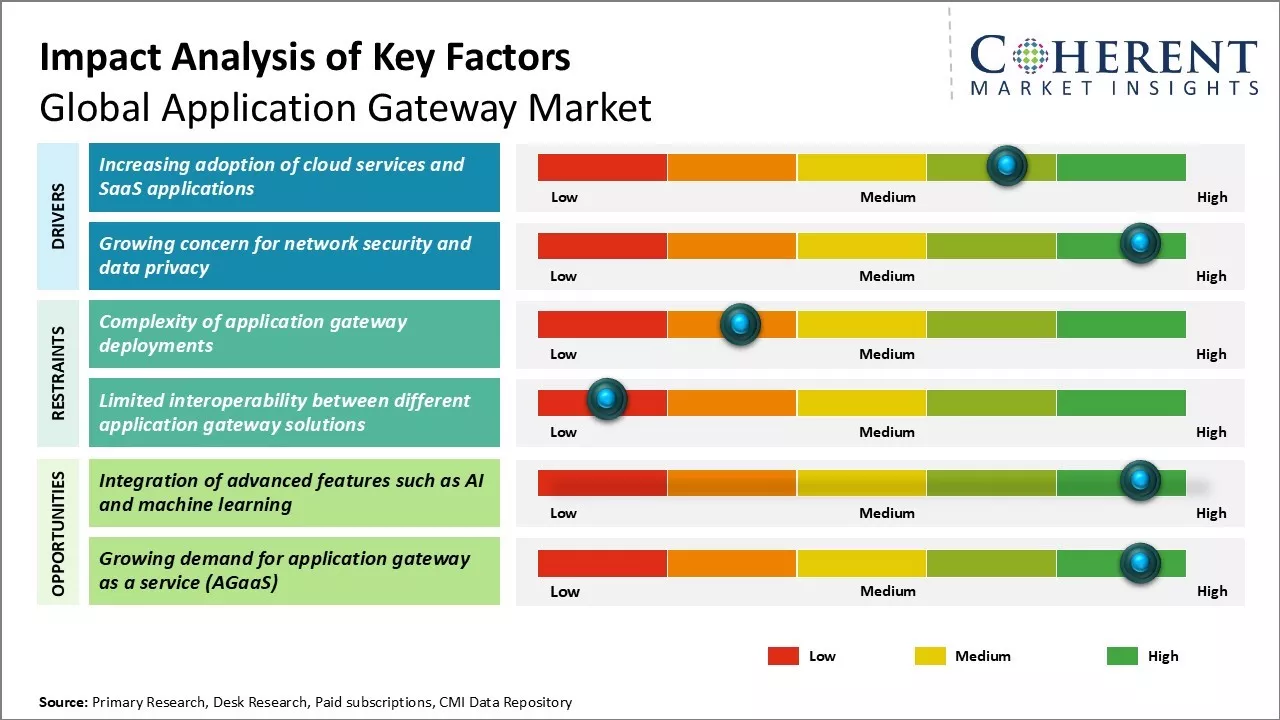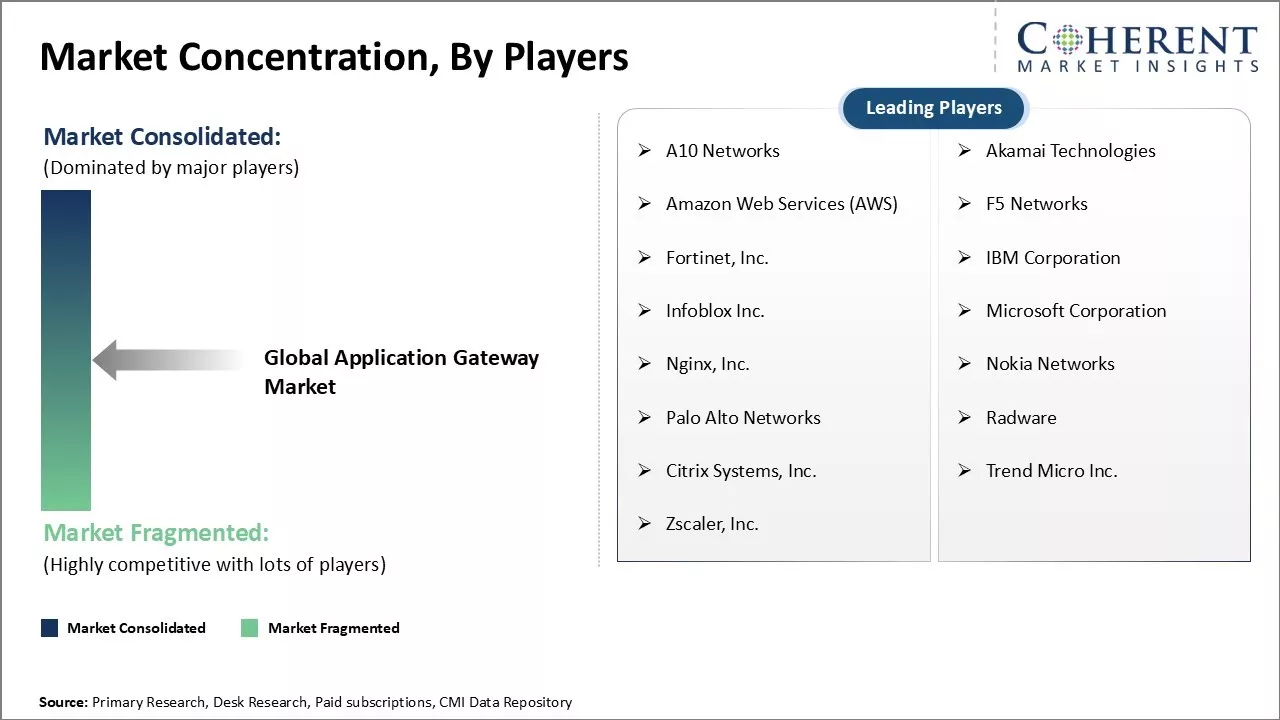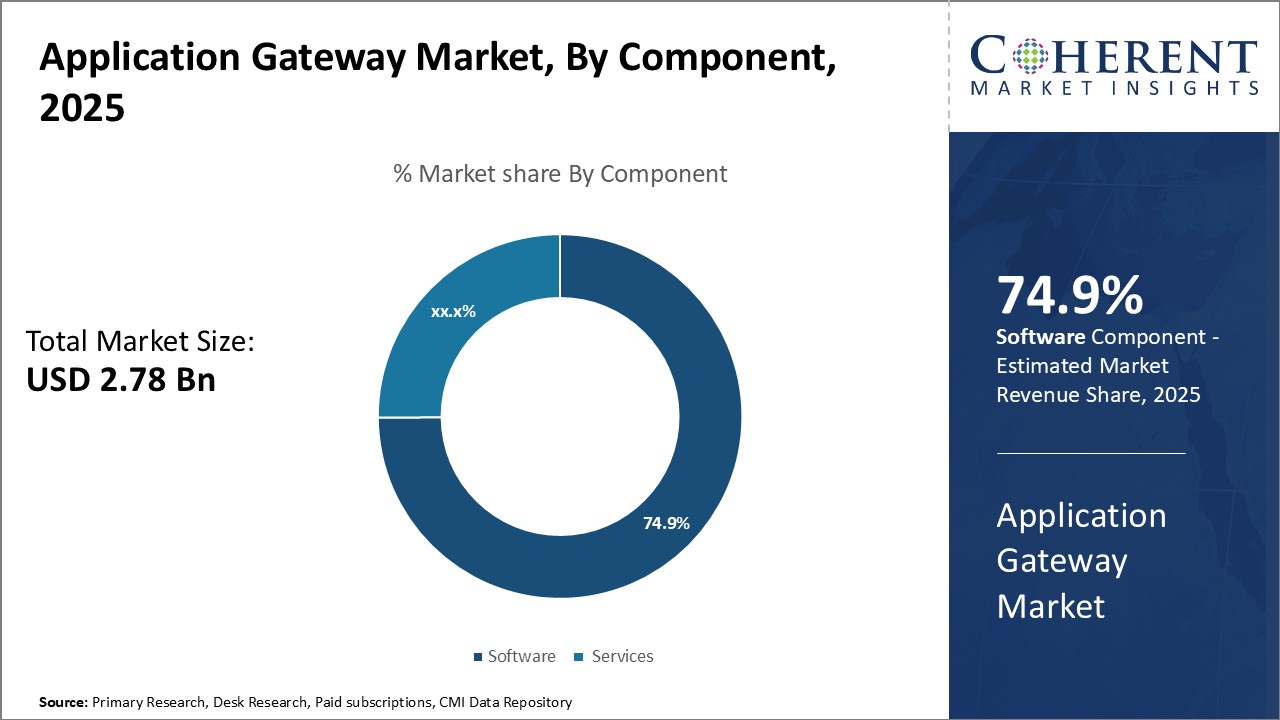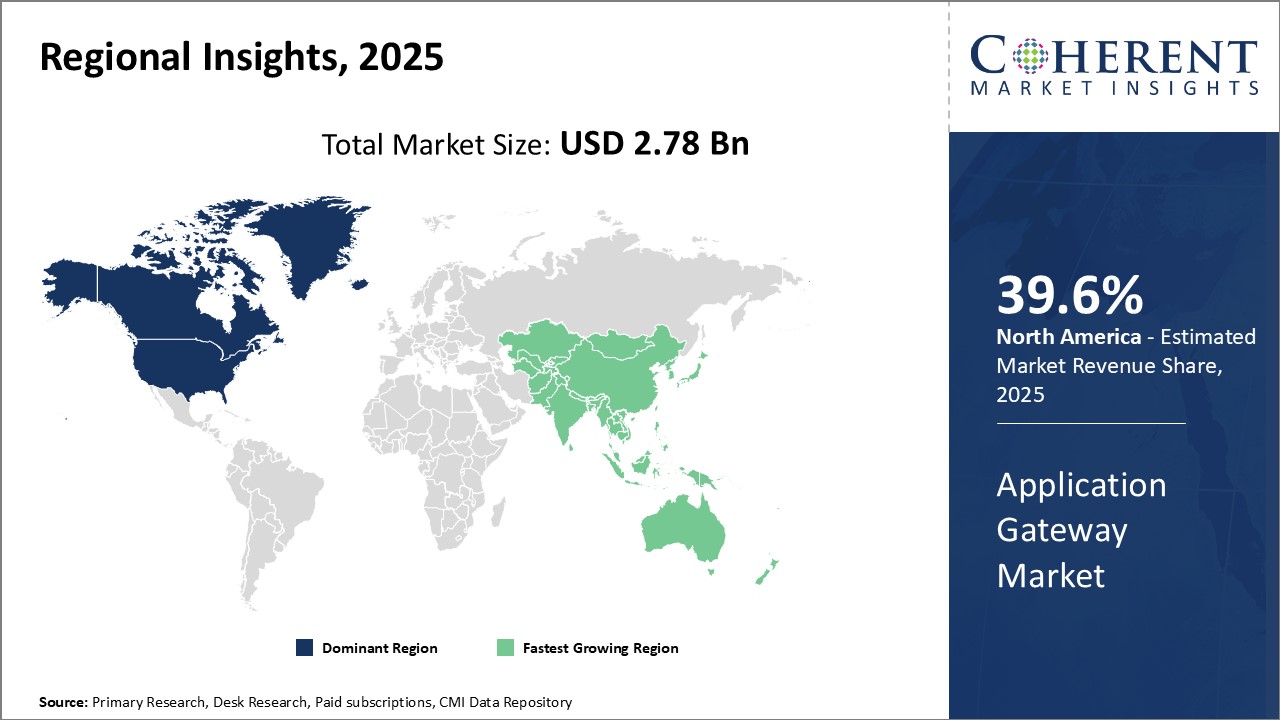Application Gateway Market Size and Trends
The global application gateway market is estimated to be valued at USD 2.78 Billion in 2025 and is expected to reach USD 5.35 Billion by 2032, exhibiting a compound annual growth rate (CAGR) of 9.8% from 2025 to 2032.

Discover market dynamics shaping the industry: Download Free Sample
Growing demand for internet security from numerous industry verticals is expected to drive the market growth. Increasing adoption of application gateways to prevent unauthorized access and ensure security of applications from outside networks is further expected to support the market growth. Additionally, rising need to control administrative tasks and optimize traffic will further augment the demand for application gateways. Implementation of application gateways help enterprises filter the inbound and outbound traffic which improves the network efficiency. This is anticipated to boost the acceptance of application gateways across various organizations during the forecast period.
Increasing adoption of cloud services and SaaS applications
With digitization coming into the forefront, businesses across various verticals are embracing cloud and SaaS based applications at a rapid pace. While cloud promises flexibility, scalability and cost benefits, it also introduces the challenges of managing traffic flow and securing organization's assets hosted in the cloud. As businesses deploy more cloud native applications, microservices and cloud APIs, there is a growing need to adopt an application delivery controller or gateway that can centrally manage traffic, provide visibility and enforce granular security policies across heterogeneous cloud environment.
Application gateways have emerged as a crucial component of modern application architecture spanning private data centers and public clouds. They offer capabilities like load balancing, acceleration, caching which help optimize the performance and user experience of cloud hosted applications. With an app gateway in place, IT teams now have granular control over traffic management without depending upon individual cloud vendor tools. They can define secure access rules, accelerate slow APIs, failover traffic during outages, etc. in a unified manner. This has become important as digital experiences are delivered through a complex mesh of both on-premise and cloud hosted application tiers. The app gateway sits at the edge and acts as a single point of management and security for the hybrid environment.
As software delivery is becoming more dynamic with microservices and serverless computing, developers need agile tools to deploy updates seamlessly. Application gateways are helping bridge this gap by supporting advanced traffic controls and policy workflows. They integrate tightly with CI/CD pipelines to enable zero downtime deployments through blue/green routing, canary releases etc. This speeds up innovation cycles while maintaining service level performance. Additionally, with app gateways enforcing access control at the edge, sensitive application code and data hosted in private clouds or data centers gain an extra layer of protection against external threats. All these factors are driving more and more enterprises to adopt application delivery controllers as the cloud footprint expands.
Market Concentration and Competitive Landscape

Get actionable strategies to beat competition: Download Free Sample
Growing Importance of Data Security
With rise in data breaches and privacy issues, security of confidential data is now a top concern for organizations globally. Stricter regulations like GDPR have also made it imperative for enterprises to bolster protection of customer and employee information handled by their digital properties. However, as business applications evolve to leverage modern techniques like open APIs, microservices and serverless computing, the traditional network perimeter is collapsing. Also, migration of workloads to public clouds exposes networks to a whole new set of threats.
In such a dynamic threat landscape, organizations are looking for modern security solutions that can adapt on the fly. Traditional firewalls alone are no longer sufficient given the stateless and ephemeral nature of modern application traffic. There is a need for advanced gateways which can enforce granular access controls, signatures, and policies at the application layer instead of just at network/transport layers. Application gateways analyze HTTP/S traffic and enable admin to define rules based on URL paths, header values, source IP, etc. paired with identity/entitlement checks. This helps secure both known and unknown vulnerabilities.
Moreover, as businesses embrace cloud-native approaches, their digital properties are also distributed across public/private infrastructures. Having a centralized point of control for traffic management and security policies becomes imperative. Application gateways provide a single pane of glass to govern access and security compliance for hybrid cloud environments. They inspect all inbound and outbound traffic at the edge to detect and block anomalies and threats. Additionally, app gateways are also effective in insulating the internal network and application tiers from direct Internet access. Overall, growing security challenges associated with modern applications and infrastructure are increasing the demand for advanced application delivery capabilities.
For instance, in January 2020, Orange Business Services, a global telecommunications company, finalized its acquisition of SecureLink, a major Europe-based cybersecurity firm. This strategic transaction is designed to bolster Orange's global footprint and fortify its cybersecurity offerings, solidifying the company's status as a preeminent player in the European cybersecurity market.
Key Takeaways from Analyst:
Growing adoption of advanced technologies like IoT, cloud computing and mobility solutions across industries is a key driver boosting the demand for application gateways. As businesses increasingly embrace digital transformation initiatives, there will be a heightened need for application gateways to secure access to cloud-based applications and services.
North America currently dominates the market owing to rapid technology adoption. However, Asia Pacific is expected to emerge as the fastest growing regional market with increasing investments in digital infrastructure by companies in countries like China and India. The growth in APAC will be supported by rising spend on application security as more firms in the region deploy web and mobile applications.
While the market outlook remains positive overall, data privacy regulations like GDPR pose compliance challenges for application gateway vendors. High initial installation and maintenance costs of these solutions could also limit their adoption among cash-strapped small businesses. Furthermore, the availability of open-source alternatives threatens to eat into the revenue of commercial application gateway providers.
To counter such restraints, vendors are focusing on developing multi-tenant SaaS-based offerings and partnering with various cloud providers to simplify deployment and drive down costs.
Market Challenges: Complexity of application gateway deployments
As application infrastructure and network environments continue to grow more complex with hybrid configurations and multi-cloud implementations, maintaining application gateways is facing greater challenges. Traditionally these gateways required hardware appliances for deployment, but modern systems leveraging software-defined components have added new layers of complexity. Ensuring application gateways can adapt to dynamic infrastructure changes while providing consistent access control, load balancing, and security measures is difficult. Platform updates and migrations also risk disrupting gateway operations if not planned and executed carefully. With organizations relying heavily on these gateways for business-critical applications, downtime or vulnerabilities can lead to major issues. Vendors must focus on simplifying deployment and management processes through automation, while also making gateways cloud-agnostic and infrastructure-agnostic to reduce these challenges of complexity as IT environments evolve.
Market Opportunities: Integration of advanced features such as AI and machine learning
The integration of cutting-edge technologies like artificial intelligence and machine learning opens significant growth opportunities for the global application gateway market. By analyzing network traffic patterns and user behaviors, gateways can automatically apply optimized configurations and policies. For example, machine learning models can detect anomalies or threats and trigger real-time responses. Also, as more applications leverage AI technologies, gateways that can understand and interface with these workloads will gain competitive advantages. Advanced features could also improve performance monitoring and get ahead of issues before they impact users. With organizations seeking to better leverage big data and analytics, application gateways that offer AI-driven recommendations and assurances will be in high demand. This integration of new capabilities can help expand the role gateways play and drive new revenue streams for vendors moving forward.

Discover high revenue pocket segments and roadmap to it: Download Free Sample
By Component - Technological advancement fuels software adoption
In terms of component, software contributes 74.9% share of the market in 2025 owing to rapid technological advancements. Application gateways essentially act as middleware, integrating legacy systems with modern applications and infrastructure. As digital transformation continues across industries, there is a growing need to interconnect outdated and new systems seamlessly. Software solutions provide the crucial functionality of protocol translation, authentication, compression, caching, and load balancing that enables this interconnectivity. vendors are constantly enhancing software with new features around API management, security, traffic management, and analytics. The modular and upgradable nature of software allows it to adapt swiftly to emerging industry demands. Additionally, software licenses are often more cost effective for businesses compared to services in the long run. With digitization continuing its relentless march, sophisticated software will remain integral to application gateways, making it the top revenue generator in this segment.
By Enterprise Size - Large enterprises spearhead Services adoption
In terms of enterprise size, large enterprises contributes 63.2% share of the market in 2025 due to higher investments in services. Being complex organizations operating on a global scale, large enterprises rely heavily on customized infrastructure and integration solutions. They often outsource application gateway management and support to specialized system integrators through managed services contracts. Service providers help set up gateways as per specific business requirements, ensure seamless operations around the clock, and provide periodic upgrades. This provides enterprises the flexibility to focus on their core business sans infrastructure challenges. Given the scale of large enterprise IT environments, even small disruptions can significantly impact productivity and revenues, making services a practical choice. Additionally, these organizations have bigger IT modernization budgets that facilitate higher services spending. Together, these factors drive large enterprises to be the primary client segment for application gateway services.
By End-use Industry - Growing IT budgets fuel demand in the IT sector
In terms of end-use industry, IT and telecom contributes 29.8% share of the market in 2025 owing to expanding IT infrastructure investments. As the pioneer adopters of digital and cloud technologies, IT companies have highly complex networks connecting myriad internal and client systems globally. Ensuring seamless data exchange between legacy platforms and new applications is paramount in this context. With continuous technology upgrades and M&A activities, the IT infrastructure landscape also undergoes frequent changes. Application gateways effectively bridge such transitions while upholding security and performance. Furthermore, the IT industry caters to a diverse client base with varying technological requirements. Gateways enable flexible integration of such diverse infrastructures. Recognizing the strategic importance, IT firms dedicate sizeable budgets to strengthen connectivity infrastructure including via application gateways. This makes IT and telecom the early technology adopter and largest end user of these platforms.
Regional Insights

Need a Different Region or Segment? Download Free Sample
North America has established itself as the dominant region in the global application gateway market. The region is expected to hold 39.6% of the market share in 2025. With strong technological infrastructure and early adoption of cloud technologies, many large enterprises based in the U.S. and Canada have been at the forefront of deploying application gateways to optimize application delivery. This region is home to technology giants like Microsoft, Cisco, and Citrix who have been pioneering application delivery controllers for decades. North American companies have traditionally valued network security and performance which has driven significant deployment of application gateways here. Moreover, the presence of global IT vendors and consultants in this region has meant that enterprises have access to the widest range of solutions and expertise when it comes to application delivery needs. Going forward, the strong culture of digitization and focus on enhancing customer experience will ensure North America's continued leadership in the application gateway space.
The Asia Pacific region has emerged as the fastest growing market for application gateways. Countries like India, China, Japan, and Australia have seen tremendous growth in internet usage, mobile adoption and digital transformations in recent years. This has led to massive surge in application traffic across industry verticals. With more companies in Asia Pacific adopting cloud-first strategies and looking for scalable ways to deliver applications to a geographically diverse user base, the demand for application gateways is accelerating. Furthermore, low deployment and management costs coupled with growing expertise pools have made Asia Pacific an attractive outsourcing destination for global companies. Several global application delivery vendors have also established strong R&D and support centers in countries like India and China to capture this growth. The booming digital economy and increasing technology investments point towards Asia Pacific dominating the application gateway landscape in the coming years.
Market Report Scope
Application Gateway Market Report Coverage
| Report Coverage | Details | ||
|---|---|---|---|
| Base Year: | 2024 | Market Size in 2025: | USD 2.78 Bn |
| Historical Data for: | 2020 To 2024 | Forecast Period: | 2025 To 2032 |
| Forecast Period 2025 to 2032 CAGR: | 9.8% | 2032 Value Projection: | USD 5.35 Bn |
| Geographies covered: |
|
||
| Segments covered: |
|
||
| Companies covered: |
A10 Networks, Akamai Technologies, Amazon Web Services (AWS), F5 Networks, Fortinet, Inc., IBM Corporation, Infoblox Inc., Microsoft Corporation, Nginx, Inc., Nokia Networks, Palo Alto Networks, Radware, Citrix Systems, Inc., Trend Micro Inc., and Zscaler, Inc. |
||
| Growth Drivers: |
|
||
| Restraints & Challenges: |
|
||
Uncover macros and micros vetted on 75+ parameters: Get instant access to report
Application Gateway Industry News
- In July 2024, io, a leading provider of cloud-native application networking solutions, announced the launch of Gloo AI Gateway. This innovative product is designed to address the growing demand for AI-driven application development by enabling organizations to build high-performance, scalable AI applications while seamlessly integrating with existing API management systems. Gloo AI Gateway offers a comprehensive set of tools and infrastructure to handle AI-specific tasks, ensuring the reliability, security, and optimal performance of AI-powered applications.
- In July 2024, Microsoft, a leading technology company, announced the launch of Azure Application Gateway for Containers, a new offering under the Application Gateway product family. This solution combines the capabilities of Azure's Application Gateway and the Application Gateway Ingress Controller (AGIC), providing layer 7 load balancing and dynamic traffic management for workloads running in Kubernetes clusters. Azure Application Gateway for Containers introduces several enhancements, including support for Gateway API, which offers a more expressive and role-oriented approach to defining Kubernetes service networking. It also enables weighted and split traffic distribution, allowing for blue-green deployment strategies and active/active or active/passive routing. This new solution extends Microsoft's application load balancing portfolio, delivering improved performance, scalability, and deployment flexibility for customers running containerized applications on Azure Kubernetes Service (AKS).
- In December 2023, IBM, a leading global technology company, announced a definitive agreement to acquire StreamSets and webMethods from Software AG, which is primarily owned by Silver Lake, a U.S.-based technology investment firm. This acquisition, valued at €2.13 billion, is expected to enhance IBM's AI and data platform, watsonx, by integrating StreamSets' advanced data ingestion capabilities. Additionally, webMethods will provide clients and partners with sophisticated integration and API management tools tailored for hybrid multi-cloud environments, further strengthening IBM's offerings in the rapidly evolving digital landscape.
- In January 2020, Orange Business Services, a global telecommunications provider, announced the completion of its acquisition of SecureLink, a prominent Europe-based cybersecurity vendor. This strategic move aims to enhance Orange's international reach and expand its cybersecurity capabilities, positioning the company as a leader in the cybersecurity industry across Europe.
*Definition: The global application gateway market refers to a network security and access solutions market that includes software and appliances for traffic management, advanced threat protection, web security, API security, and others. As organizations increasingly adopt cloud-based applications and services, the global application gateway market provides secure access and visibility across boundaries between users, applications, and networks to help modern businesses securely connect users to applications.
Market Segmentation
- By Component Insights (Revenue, USD Bn, 2020 - 2032)
-
- Software
- Services
- By Enterprise Size Insights (Revenue, USD Bn, 2020 - 2032)
-
- Large Enterprises
- Small and Medium-Sized Enterprises (SMEs)
- By End-use Industry Insights (Revenue, USD Bn, 2020 - 2032)
-
- IT and Telecom
- BFSI (Banking, Financial Services, and Insurance)
- Retail and E-Commerce
- Healthcare
- Manufacturing
- Others
- By Regional Insights (Revenue, USD Bn 2020 - 2032)
- North America
- U.S.
- Canada
- Latin America
- Brazil
- Argentina
- Mexico
- Rest of Latin America
- Europe
- Germany
- U.K.
- Spain
- France
- Italy
- Russia
- Rest of Europe
- Asia Pacific
- China
- India
- Japan
- Australia
- South Korea
- ASEAN
- Rest of Asia Pacific
- Middle East
- GCC Countries
- Israel
- Rest of Middle East
- Africa
- South Africa
- North Africa
- Central Africa
- North America
- Key Players Insights
-
- A10 Networks
- Akamai Technologies
- Amazon Web Services (AWS)
- F5 Networks
- Fortinet, Inc.
- IBM Corporation
- Infoblox Inc.
- Microsoft Corporation
- Nginx, Inc.
- Nokia Networks
- Palo Alto Networks
- Radware
- Citrix Systems, Inc.
- Trend Micro Inc.
- Zscaler, Inc.
Share
Share
About Author
Suraj Bhanudas Jagtap is a seasoned Senior Management Consultant with over 7 years of experience. He has served Fortune 500 companies and startups, helping clients with cross broader expansion and market entry access strategies. He has played significant role in offering strategic viewpoints and actionable insights for various client’s projects including demand analysis, and competitive analysis, identifying right channel partner among others.
Missing comfort of reading report in your local language? Find your preferred language :
Transform your Strategy with Exclusive Trending Reports :
Frequently Asked Questions
EXISTING CLIENTELE
Joining thousands of companies around the world committed to making the Excellent Business Solutions.
View All Our Clients

